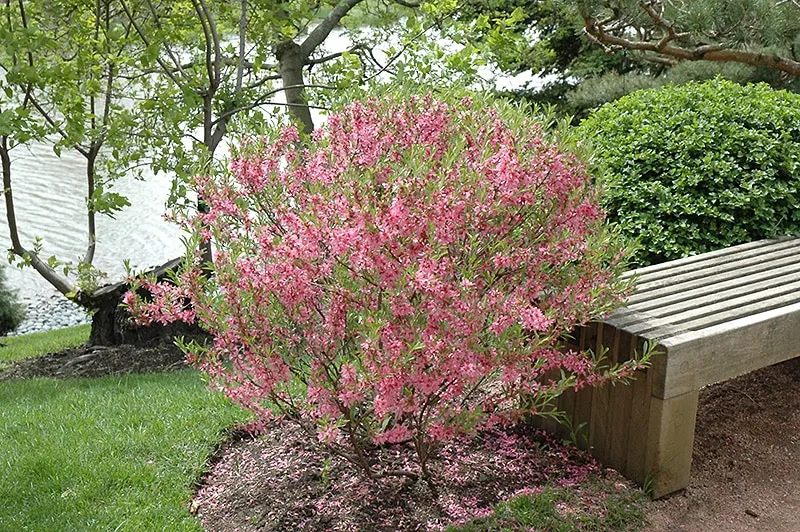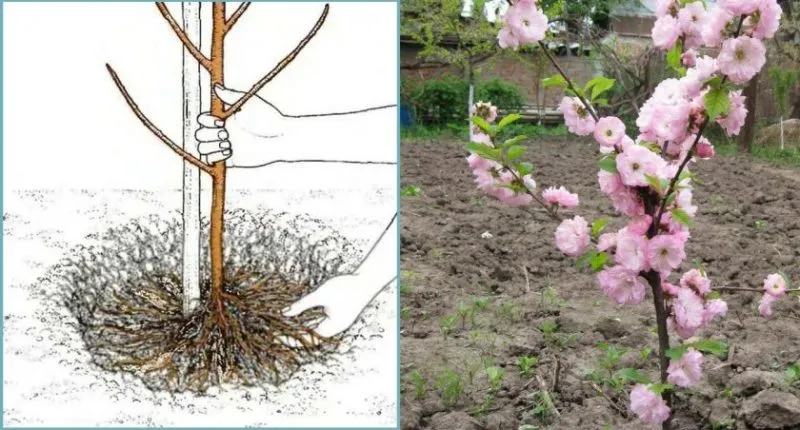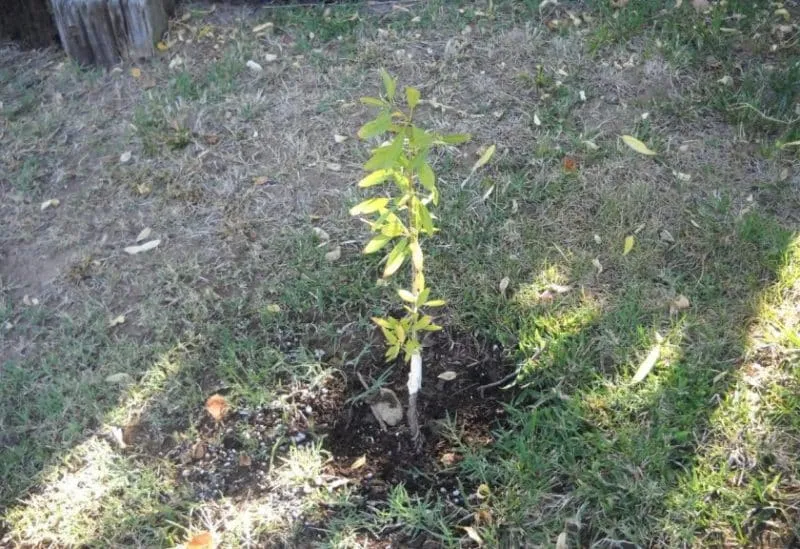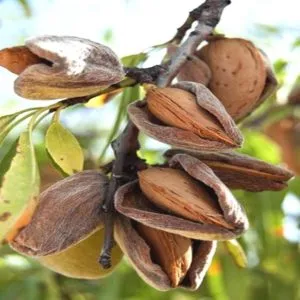Almond — a unique tree. It boasts a delicate fragrance, beautiful pink-white blossoms, and delicious, nutritious nuts. Once cultivated only in the south, almond trees have now adapted to more temperate regions across Europe. You can find them in countries like Spain, Italy, and even as far north as Germany and the UK.
Successful cultivation largely depends on when and how the tree is planted. In this article, we’ll explore how to grow almonds in open ground and care for them in your garden.
Table of contents
Can You Plant Almonds in Autumn?
Almonds can be planted in either spring or autumn — the choice depends on the planting method and the growing region. For autumn planting, prepare the holes in early summer — dig them out and enrich them with organic fertilisers such as manure slurry, wood ash, compost, or peat.
Pros and Cons of Autumn Planting

In autumn, seedlings are the preferred planting method. If you use seeds, rodents like mice and moles may destroy them. Autumn also offers ideal weather and humidity levels for almond trees — gardeners won’t need to water as frequently as in spring.
An autumn-planted seedling will start growing much earlier than one planted in spring. This is because the soil is already warm and has been treated for diseases and pests throughout the summer.
Note! Another advantage of autumn planting is the discounted price of almond seedlings. The planting material is treated and placed directly in the ground, eliminating the need for storage, as is the case with spring planting.
Sometimes, poor growth results from infected or damaged planting material. This can happen in spring as well. Issues may also arise if the seedling is planted too late, causing the cold-sensitive almond tree to suffer frost damage.
When to Plant Almonds in Autumn
Planting should begin before other garden trees shed their leaves.
In southern Europe, mid-October is ideal, while in central regions, late September is best. Northern areas (like Scandinavia) are unsuitable for almond cultivation due to their harsh climate.
The perfect day for planting is dry and warm, with temperatures no lower than +10°C and humidity around 80-85%. Avoid windy or rainy days. Always consider regional climate conditions when choosing a date.
Some gardeners follow the lunar calendar for planting, though the author considers this a superstition and won’t list specific dates here.
What do you think about planting by the lunar calendar? Share your thoughts in the comments below.
Choosing the Right Location

Almonds thrive in sunlight, so plant them in open, sunny areas — shade or partial shade won’t work. Insufficient light slows leaf and flower development, leading to a dense canopy with dying inner branches. Avoid planting near houses or garden structures that cast shadows.
Choose elevated ground to prevent waterlogging and root rot. High groundwater levels increase the risk of fungal diseases. Keep almond trees away from open water sources. Experienced gardeners prefer gentle slopes for planting.
Good neighbours for almond trees include low-growing shrubs like raspberries, blackcurrants, redcurrants, serviceberries, and gooseberries. Nightshades or herbs also work well. Avoid tall fruit trees like pears, apples, plums, apricots, or peaches, as they compete for sunlight.
Preparing the Soil
Almonds aren’t overly picky about soil type — they grow well in light clay, sandy, or even rocky soils. However, nutrient-rich, mineral-dense soils yield the best harvests.
Heavy clay or highly acidic soils (pH below 4.5 or above 7.5) are unsuitable for cultivation.
Preparing the Planting Hole
Remove weeds, fallen leaves, and debris from the area. Dig a hole 50 cm deep and 60 cm wide 2-3 months before planting. Three weeks prior, enrich it with organic and mineral fertilisers — 5 kg of well-rotted manure and 500 g of superphosphate.
Fill the hole with a mix of equal parts turf, store-bought, and leaf soil. Adding river sand improves soil aeration. For acidic soil, mix in 150 g of chalk or lime per square metre.
Place a drainage layer of broken bricks or gravel at the bottom. Insert a tall stake (at least 50 cm above ground) in the centre as a support for the seedling.
Note! For cross-pollination, grow 3-4 compatible varieties. Space trees 3-5 m apart, with 5 m between rows.
Selecting Planting Material
Buy seedlings from specialised nurseries. Ensure the variety suits your region. For example, in cooler climates, opt for frost-resistant varieties like Ferragnès or Lauranne.
Choose healthy-looking seedlings, free of spots, damage, or rot. Before planting, dip the roots in a clay slurry to protect against disease and aid adaptation.
Planting Almond Nuts

Another way to grow an almond tree is from a nut. In late spring or summer, prepare shelled, dry almonds for sprouting. Soak the largest nuts in room-temperature water for 10-12 hours, then rinse and soak for another 8 hours. Once swollen and cracked, they’re ready for planting.
Plant them in deep pots with nutrient-rich soil, burying them 10-12 cm deep. Cover with loose soil, water well, and place on a sunny windowsill. Water and fertilise regularly. Sprouts appear in 5-6 weeks. Transplant outdoors once the tree reaches 1 m.
How to Plant Almonds Correctly in Autumn
Follow this step-by-step guide to ensure healthy growth and a bountiful harvest.

Step-by-Step Planting Guide
Plant on a cloudy morning. After dipping the roots in clay slurry, proceed as follows:
- Place soil over the drainage layer to form a small mound.
- Set the seedling in the centre, spreading the roots outward.
- Position the root collar 2-3 cm above ground level.
- Fill the hole with soil, ensuring no air pockets remain.
- Tamp down the soil and water thoroughly.
- Mulch with peat, sawdust, or dry soil, covering the root collar by 3-4 cm.
- Once the soil settles, tie the seedling to the support stake.
Common Mistakes to Avoid
Damaging the roots during planting can stunt growth and weaken the tree. Poor site selection — such as near apple trees, pears, or waterlogged areas — also harms development.
Avoid buying unhealthy seedlings from unreliable sellers. Heavy, acidic soil further hampers growth.
Regional Planting Tips
In southern Europe, proper drainage is essential to prevent root diseases caused by heat and humidity. Use materials like ceramic shards, charcoal, moss, or gravel for drainage.
In central Europe, enrich the planting hole with mineral fertilisers (e.g., 200 g of double superphosphate or 150 g of potassium sulphate) to boost frost resistance. No further fertilisation is needed for two years.
Post-Planting Care
Water only when the soil dries out. Avoid soaking the root collar. Use 10 litres of water per tree. After watering, loosen the soil to 5-6 cm depth to improve absorption. Remove weeds to deter pests like aphids and spider mites.
In spring, apply fertilisers such as cow manure slurry, compost, or mineral blends (e.g., 10 g of ammonium nitrate and 5 g of urea per 5 litres of water). This strengthens immunity against diseases like bacterial canker and root rot.
Expert Tips
Almond planting follows standard tree-planting principles. For best results:
- Plant in sunny, well-drained spots away from groundwater.
- Pre-fertilise the hole with manure or compost.
- Ensure proper drainage.
- Use clay slurry for root protection.
- Maintain proper spacing and companion planting.
- Plant before autumn leaf fall.
- Provide sturdy support.
- Water only as needed.
- Prune in the second year for shape.
Conclusion
Autumn is the ideal time to plant almonds, typically using seedlings. Prepare a 60 cm-deep hole with organic fertiliser and drainage. Plant in full sun, avoiding shade from buildings or other trees. After planting, water, mulch, and support the seedling for optimal growth.







